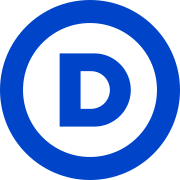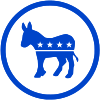
Back Demokratiese Party (Verenigde State) Afrikaans Demokratische Partei (USA) ALS ዴሞክራቲክ ፓርቲ (አሜሪካ) Amharic الحزب الديمقراطي (الولايات المتحدة) Arabic ܓܒܐ ܕܝܡܘܩܪܛܝܐ (ܐܘܚܕܢܐ ܡܚܝܕܐ) ARC الحزب الديموقراطى فى امريكا ARZ Partíu Demócrata (Estaos Xuníos) AST Demokratlar Partiyası (ABŞ) Azerbaijani دموکرات حیزبی (بیرلشمیش ایالتلر) AZB Partai Démokrat (Amérika Serikat) BAN
Democratic Party | |
|---|---|
 | |
| Chairperson | Jaime Harrison |
| Governing body | Democratic National Committee[1][2] |
| U.S. President | Joe Biden |
| U.S. Vice President | Kamala Harris |
| Senate Majority Leader | Chuck Schumer |
| House Minority Leader | Hakeem Jeffries |
| Founders | |
| Founded | January 8, 1828[3] Baltimore, Maryland, U.S. |
| Preceded by | Democratic-Republican Party |
| Headquarters | 430 South Capitol St. SE, Washington, D.C., U.S. |
| Student wing | |
| Youth wing | Young Democrats of America |
| Women's wing | National Federation of Democratic Women |
| LGBT wing | Stonewall Democrats |
| Overseas wing | Democrats Abroad |
| Ideology | |
| Political position | Center-left[b] |
| Caucuses | Blue Dog Coalition New Democrat Coalition Congressional Progressive Caucus |
| Colors | Blue |
| Senate | 47 / 100[c] |
| House of Representatives | 212 / 435 |
| State Governors | 23 / 50 |
| State upper chambers | 857 / 1,973 |
| State lower chambers | 2,425 / 5,413 |
| Territorial Governors | 4 / 5 |
| Seats in Territorial upper chambers | 31 / 97 |
| Seats in Territorial lower chambers | 9 / 91 |
| Election symbol | |
 | |
| Website | |
| democrats | |
The United States Democratic Party is one of the two biggest political parties in the United States. Since the mid-1850's, the party's main opponent has been the Republican Party. Both political parties have controlled American politics ever since.
The party sits at the center to center-left of the American political spectrum, with the Republican Party being positioned to their right.
Every four years the party holds a National Convention where they agree on their candidate for president. The Democratic National Committee coordinates most of the activities of the Democratic Party in all 50 United States. Since Andrew Jackson's inauguration in 1829, there have been 16 Democratic presidents. The most recent and current is Joe Biden who took office as the 46th president of the United States in January 2021.
The Democratic Party represents a broad spectrum of liberal and left-wing ideologies,including but not limited toclassical liberalism, social democracy, progressivism, and social modern liberalism.
- ↑ "About the Democratic Party". Democratic Party. Archived from the original on April 6, 2022. Retrieved April 15, 2022.
For 171 years, [the Democratic National Committee] has been responsible for governing the Democratic Party
- ↑ Democratic Party (March 12, 2022). "The Charter & The Bylaws of the Democratic Party of the United States" (PDF). p. 3. Archived (PDF) from the original on March 27, 2022. Retrieved April 15, 2022.
The Democratic National Committee shall have general responsibility for the affairs of the Democratic Party between National Conventions
- ↑ Cole, Donald B. (1970). Jacksonian Democracy in New Hampshire, 1800–1851. Harvard University Press. p. 69. ISBN 978-0-67-428368-8.
- ↑ Cite error: The named reference
sarnoldwas used but no text was provided for refs named (see the help page). - ↑ Bacon, Perry Jr. (March 11, 2019). "The Six Wings Of The Democratic Party". FiveThirtyEight. Archived from the original on August 15, 2021. Retrieved October 21, 2021.
- ↑ Stein, Letita; Cornwell, Susan; Tanfani, Joseph (August 23, 2018). "Inside the progressive movement roiling the Democratic Party". Reuters. Archived from the original on June 13, 2022. Retrieved June 13, 2022.
- ↑ Rae, Nicol C. (June 2007). "Be Careful What You Wish For: The Rise of Responsible Parties in American National Politics". Annual Review of Political Science. 10 (1). Annual Reviews: 169–191. doi:10.1146/annurev.polisci.10.071105.100750. ISSN 1094-2939.
What are we to make of American parties at the dawn of the twenty-first century? ... The impact of the 1960s civil rights revolution has been to create two more ideologically coherent parties: a generally liberal or center-left party and a conservative party.
- ↑ Marantz, Andrew (May 24, 2021). "Are We Entering a New Political Era?". The New Yorker. New York, New York: Condé Nast. Archived from the original on April 19, 2024. Retrieved June 16, 2024.
Moderation may be relative, but moderates still run the Democratic Party.
- ↑ Bruner, Christopher M. (2018). "Center-Left Politics and Corporate Governance: What Is the 'Progressive' Agenda?". BYU Law Review. 2018 (2). Digital Commons: 267–334. doi:10.2139/ssrn.2917253. ISSN 2162-8572. SSRN 2917253.
This article has argued that a widespread and fundamental reorientation of the Democratic Party toward decidedly centrist national politics over recent decades fundamentally altered the role of corporate governance, and related issues, in the project of assembling a competitive electoral coalition.
- ↑ Coates, David, ed. (2012). "Liberalism, Center-left". The Oxford Companion to American Politics. Oxford University Press. pp. 68–69. doi:10.1093/acref/9780199764310.001.0001. ISBN 978-0-19-976431-0.
Observes that the terms "progressive" and "liberal" are "often used interchangeably" in political discourse regarding "the center-left".
- ↑ Cronin, James E.; Ross, George W.; Shoch, James (August 24, 2011). "Introduction: The New World of the Center-Left". What's Left of the Left: Democrats and Social Democrats in Challenging Times. Duke University Press. ISBN 978-0-8223-5079-8. pp. 17, 22, 182:
Including the American Democratic Party in a comparative analysis of center-left parties is unorthodox, since unlike Europe, America has not produced a socialist movement tied to a strong union movement. Yet the Democrats may have become center-left before anyone else, obliged by their different historical trajectory to build complex alliances with social groups other than the working class and to deal with unusually powerful capitalists ... Taken together, the three chapters devoted to the United States show that the center-left in America faces much the same set of problems as elsewhere and, especially in light of the election results from 2008, that the Democratic Party's potential to win elections, despite its current slide in approval, may be at least equal to that of any center-left party in Europe ... Despite the setback in the 2010 midterms, together the foregoing trends have put the Democrats in a position to eventually build a dominant center-left majority in the United States.
- ↑ Hacker, Jacob S.; Malpas, Amelia; Pierson, Paul; Zacher, Sam (December 27, 2023). "Bridging the Blue Divide: The Democrats' New Metro Coalition and the Unexpected Prominence of Redistribution". Perspectives on Politics. Cambridge University Press on behalf of the American Political Science Association: 3. doi:10.1017/S1537592723002931. ISSN 1537-5927.
We conclude by considering why Democrats have taken this course, why they are not perceived as having done so, and why, at this fraught juncture for American democratic capitalism, political scientists could learn much from closer examination of the rich world's largest center-left party.
- ↑ Cite error: The named reference
Polarized by Degreeswas used but no text was provided for refs named (see the help page).
<ref group=lower-alpha> tags or {{efn}} templates on this page, but the references will not show without a {{reflist|group=lower-alpha}} template or {{notelist}} template (see the help page).